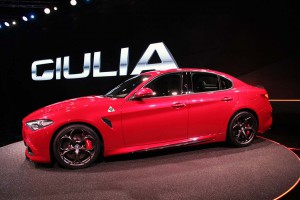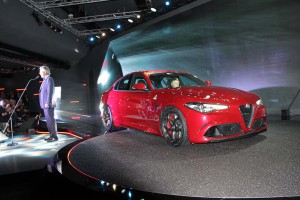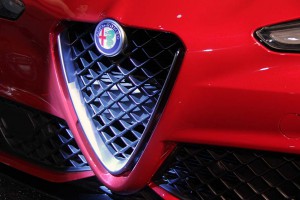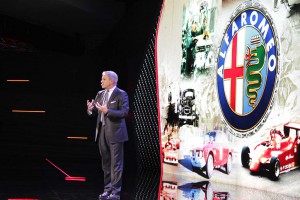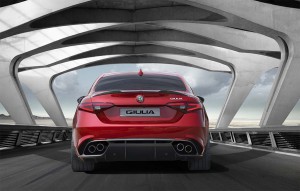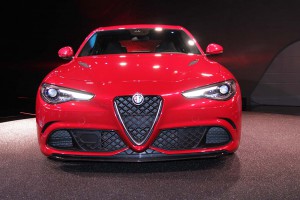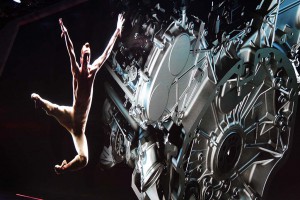With acclaimed opera singer Andrea Bocelli sharing the stage, Alfa Romeo rolled out its new Giulia sedan during a packed news conference in Milan, Italy on Wednesday.
Alfa can only hope it has hit a high note with the launch of the new performance model once it rolls into showrooms early next year. The Alfa Romeo Giulia sedan will be going up against a crowded field of luxury competitors, including the likes of the vaunted BMW 3-Series and the Mercedes-Benz C-Class.
The challenge will be especially tough in the U.S. which is expected to be the single market for the new Alfa Giulia – and for Alfa Romeo on the whole. The brand has largely been absent for more than two decades, something company officials suggested can be both a plus and a minus for the ambitious Italian brand.
“There’s nothing about the brand that needed to change. We needed to change ourselves,” suggested Harald Wester, the head of Alfa Romeo, as he opened up the news conference.
That was a clear reference to the fact that recent Alfa models simply haven’t generated much enthusiasm and have largely vanished from every market except Europe. To go back to what he described as the basic DNA of the 105-year-old brand, Alfa took a cue from the legendary skunkworks operation at aerospace manufacturer Lockheed. It set up a secret development team scattered across Italy that will eventually grow to 600 to 700 designers and engineers as they move on to the next series of Alfa products.
(Click Here for a first drive of the Alfa Romeo 4C Spider.)
A small SUV is expected to come net, followed by an assortment of sedans, coupes, sports cars and crossovers. Ultimately, there will be eight models, Fiat Chrysler CEO Sergio Marchionne confirmed, capping a five-year development program valued at 5 billion Euros, or about $6 billion at current exchange rates.
The new Giulia is meant to personify the five brand pillars Alfa officials outlined during a critical brand strategy session in May 2014, including advanced powertrains, a 50-50 weight balance, class-leading power-to-weight ratios, advanced and unique technologies, and distinctly Italian design.
Though approximately the same length as a BMW 3-Series, the new Alfa Romeo Giulia clearly lives up to the latter objective, with a shape design director Lorenzo Ramaciotti described as “quasi-organic tension.” It dispenses with the sharp angles and creases many competitors have adopted, favoring a more sculptural look with only a few distinct lines, such as the one surging out of the port on the front fender and linking the front and rear door handles.
No surprise, the Giulia retains the familiar, tri-foil grille that has long been the most recognizable element of Alfa design. But the nose is far more balanced in overall appearance than older models, including the most recent Giulia.
(Ralph Gilles, Chrysler’s head of design, named new styling chief for Alfa, as well. Click Here for more.)
The version of the Alfa Giulia that rolled out on the stage at Alfa headquarters also bore a green four-leaf clover, the symbol of the brand’s Quadrifoglio models – the equivalent of the BMW M and Mercedes AMG performance lines.
While few hard numbers were offered on Wednesday, CEO Marchionne revealed the Alfa Romeo Giulia Quadrifoglio’s Ferrari-derived, turbocharged V-6 engine will make 510-horsepower and launch the sedan from 0 to 100 kmh, or 0 to 62.5 mph, in 3.9 seconds.
Despite what the name might imply, past Quadrifoglio models were not necessarily all-wheel-drive. The basic platform for the Giulia is rear-drive. But an Alfa source hinted that the performance series may, indeed, be migrating to all-wheel-drive in the future. That would be no surprise considering rival Mercedes plans to make virtually all AMG models AWD going forward.
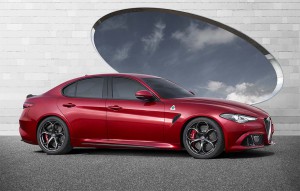
A factory shot of the Alfa Giulia reveals the 4-leaf clover, meaning its the 510-hp Quadrifoglio version.
Even rear-wheel-drive versions of the Giulia will get a new torque vectoring system that will use a dual clutch and differential layout to shift torque, as needed, between the rear wheels to retain maximum traction.
Te new Alfa Giulia will feature such pluses as carbon fiber brakes on some versions. Along with the extensive use of aluminum, composites and carbon fiber, company officials hinted the new model will be among the lightest in the segment and have a “perfect” 50:50 weight balance.
On the technology side, the Alfa will use a mix of mechanical and digital systems to maximize traction and improve aerodynamics. That includes what was described as a “Front Active Aero Splitter” that is apparently designed to maximize downforce at high speeds.
The various electronic chassis, engine and brake control systems will all be linked through a “neural network” to ensure they all work together harmoniously. Meanwhile, a driver will be able to shift the way they operate depending on whether the Giulia is put into economy, “Natural,” dynamic or “Race” mode.
The so-called DNA Selector will be one of relatively few controls on the center console, a second rotary knob offered as a way to control the Alfa Giulia’s infotainment system.
“Paradoxically, being different for Alfa meant rediscovering what it once was,” said FCA CEO Marchionne. He promised that the same steps taken to develop the new Giulia will be used with the rest of the promised line-up.
While the new sedan may have won a broad round of applause during its debut, it remains to be seen how the public will react. Right now, Alfa is available in only a handful of markets, primarily Europe, and generated an anemic 68,000 sales last year. The goal is to get that up to 400,000 by 2018, Marchionne noted, with nearly 40% of that volume targeted at the highly competitive American market.
(Alfa sibling brand Maserati hits the silk trail with fashion house Zegna. Click Here for the story.)
Alfa left there more than a quarter century ago, a victim of quality problems that led to a sharp decline in sales. It has attempted several halfhearted comebacks, only giving the effort a serious push following the pairing of Fiat and Chrysler. Late last year, the new Alfa Romeo 4C came to market, a convertible version just set to join it. But all told, the largely hand-built sports car is expected only to generate about 2,500 sales annually. It will be up to the Giulia to start rolling up real numbers.
On the downside, Alfa Romeo will have to rebuilt almost entirely from scratch in the U.S. – though it will at least have the Chrysler side of the company to help it with distribution, American brand chief Reid Bigland told TheDetroitBureau.com earlier this month. The bad thing is that few potential buyers know about Alfa. The good news, he added, is that few recall the quality problems that led it to flee the country.
So, along with delivering a sexy design and powerful engines, Alfa is going to have to make sure it can deliver a reliable ride. That could prove the biggest challenge of all, caution industry analysts.
In a new report, consultancy IHS Automotive was clearly skeptical cautioning that it does not believe, “the brand will meet its self-set targets—though we do see expansion and for Alfa Romeo to gain ground and set the stage for a new position in the market over time. Brand rebuilding easily can take 15 to 20 years, and there are no indications that Alfa Romeo has any advantage for short-circuiting the process.”

